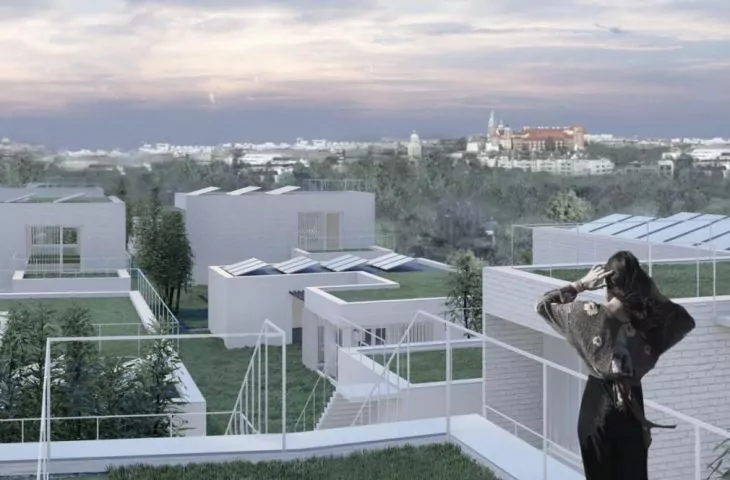Work submitted for the competition
"Best Diploma Architecture"
A complex of single-family houses in Cracow was designed on the outskirts of Bielańsko-Tyniecki Landscape Park, next to the Zakrzówek lagoon, according to the trend of contemporary sustainable architecture.



bird's eye view
© Sebastian Krawczyk
The goal of the work was to create a housing development using materials of natural origin instead of traditional building products, which is expected to contribute to reducing emissions of harmful substances created during production and reducing the energy required for their extraction and processing. Bulk, non-renewable, energy-intensive materials such as cement and concrete, as well as products containing toxic chemicals, fire retardants that threaten health, were excluded from the project as much as possible. The idea behind the KoMo single-family home complex project was to create a development whose buildings would be as environmentally friendly as possible throughout their life cycle.



visualization
© Sebastian Krawczyk
Hempcrete composite and a wooden substructure were used to create the prefabricated building elements. Hempcrete is a plant-based composite material obtained from industrial hemp shives, lime and water. It performs insulating functions, so it is placed inside the wooden support structure. The main advantage of hemp concrete is the minus emission rate ofCO2 production. The amount of carbon dioxide absorbed by industrial hemp during growth far exceeds the amount of CO2 released during concrete production. Other advantages of Hempcrete include fire resistance, improved room acoustics or natural cooling in summer and heating in winter. In addition, the material is fully recyclable. Waste from a demolished building can be reused in the next mix or left to decompose - hempcrete will decompose over time, returning lime and organic matter to the soil.
axonometry of the entire assembly
© Sebastian Krawczyk
One common design module was adopted for the development of the projections and urbanism. Two basic projections and additions were planned, creating a responsive architecture. The designed complex of single-family houses demonstrates the possibilities of adapting technology to different audiences. For the purposes of the work, eight user profiles were adopted: single, couple of friends, married couple, couple expecting a child, 2+1 family, 2+2 family, elderly couple - a person with mobility disabilities, two-generation family or a couple renting part of the house to a 2+2 family. At the same time, each object is a transitional stage.
floor plans of sample houses
© Sebastian Krawczyk
A proprietary design of prefabricated modular building elements using hemp concrete and a wooden load-bearing frame was developed.
Natural ventilation is provided in the buildings for most of the year. All rooms have tilt window elements. For periods of extremes (hot summer and cold winter), mechanical supply/exhaust ventilation with heat/cooling recovery was designed. The recuperation unit is located in the technical room. Domestic hot water is provided by a heat pump.
energy diagrams, a diagram of the advantages of the pool situation next to the house and a diagram of the advantages of hemp concrete
© Sebastian Krawczyk
Rainwater is collected in a tank located underground and used for watering plants. Gray water is reused for flushing toilets. The main source is electricity produced by photovoltaic panels located on the technical terraces.
The estate is intended to be educational and promote energy-active solutions.
Sebastian KRAWCZYK
Illustrations: © Author




















































